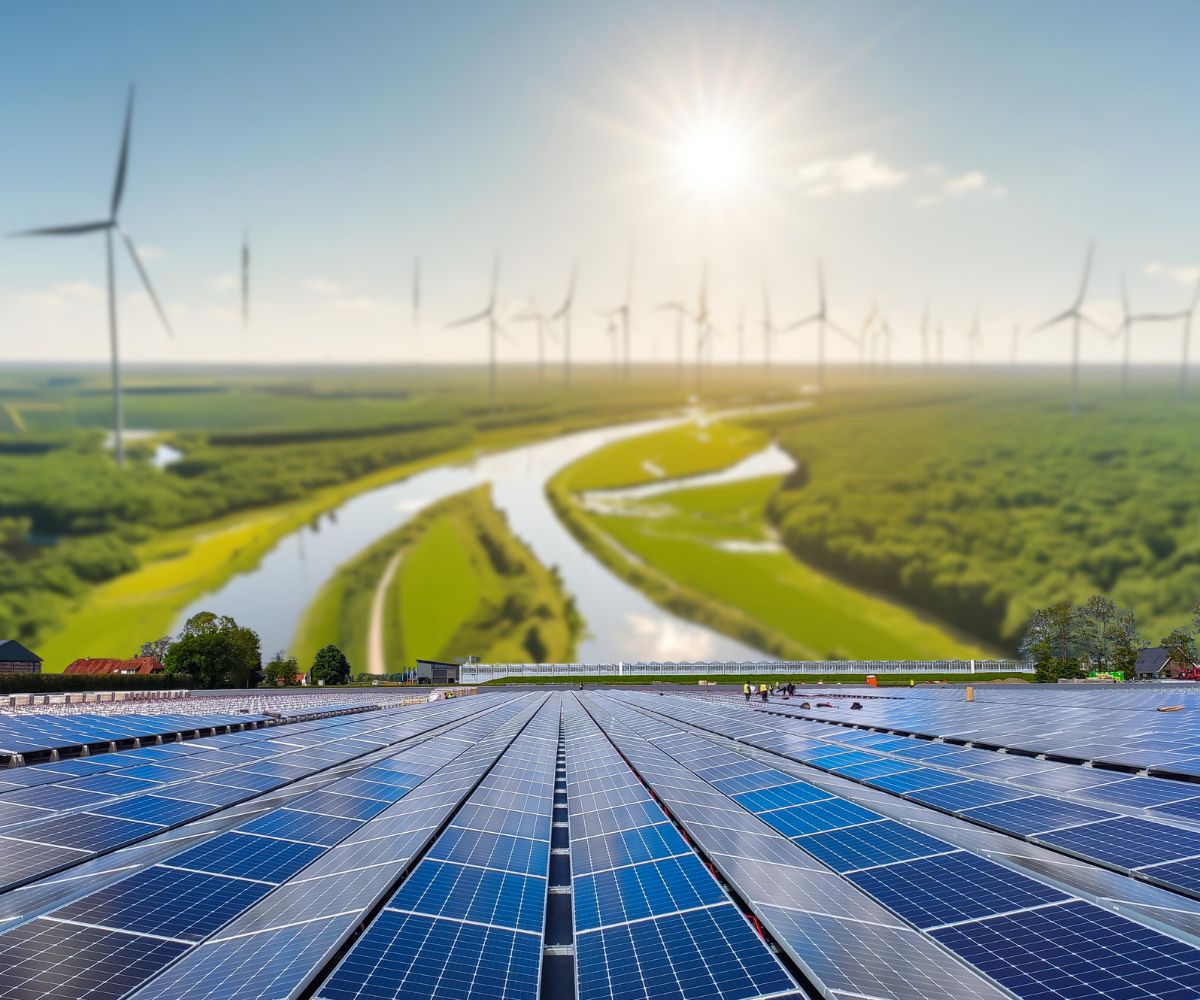
Rudong County’s Solar-Hydrogen Park is Saving 151,000 Tons of Coal Annually
January 6, 2025China’s Rudong Marine Solar PV and Hydrogen Storage Project Begins Operation
The Rudong marine solar photovoltaic (PV) and hydrogen storage project in Rudong County, Jiangsu Province, China, marks a pivotal step in renewable energy innovation. Developed by Guohua Energy Investment Co., Ltd., a subsidiary of China Energy Investment Group (CHN Energy), this large-scale renewable energy park has now commenced operations, linking to the grid on December 31, 2024.
Spanning 287 hectares of tidal flat terrain, the facility integrates cutting-edge PV power generation, hydrogen production via water electrolysis, hydrogen refueling, and energy storage into a single comprehensive operational system. With a total installed capacity of 400 megawatts, the project represents a synthesis of technological advancements aimed at driving a cleaner, more sustainable future.
Key Points for Solar Hydrogen Plant’s Operation and Goals:
- The Rudong Integrated Photovoltaic (PV)-Hydrogen-Storage Project was successfully connected to the grid.
- Operated by CHN Energy’s Guohua Energy Investment Co., Ltd., it is China’s first integrated offshore facility combining PV power generation, hydrogen production and refueling, and energy storage.
- Located on coastal tidal flats in the Yudong Reclamation Area, Rudong County, the project spans 287 hectares (4,300 mu).
- It has a total installed capacity of 400 megawatts and features a 220 kV onshore booster station, a 60 MW/120 MWh energy storage facility, and a hydrogen production and refueling station.
- The hydrogen production capacity is 1,500 cubic meters per hour, while the refueling capacity is 500 kilograms per day.
- Part of China’s Desert, Gobi, and Rocky Areas Mega Wind and Solar Base Projects, it is expected to generate 468 million kilowatt-hours of electricity annually.
- Environmental benefits include annual reductions of approximately 309,400 tons of carbon dioxide, 562.6 tons of sulfur dioxide, and 1,125.3 tons of nitrogen dioxide.
- Advanced PV technology and intelligent control systems are used to optimize energy conversion and storage efficiency.
- Hydrogen production through water electrolysis further enhances overall energy utilization efficiency.
- The project improves grid stability and offers peak-shaving capabilities for the regional energy infrastructure.
- By leveraging tidal flat resources and integrating cutting-edge technology, it marks a significant step in renewable energy innovation and coastal ecological restoration.
How the Technology Works
The Rudong project is an exemplary showcase of marine solar PV technology combined with hydrogen production and storage capabilities.
-
Photovoltaic Power Generation
The park utilizes advanced solar PV systems optimized for tidal flat environments. Solar panels capture sunlight and convert it directly into electricity using semiconducting materials that exhibit the photovoltaic effect. This electricity powers both regional energy networks and other linked systems like hydrogen electrolysis. -
Hydrogen Production via Electrolysis
Excess electricity from the PV system is used to split water molecules into hydrogen and oxygen through electrolysis. This conversion is made efficient by intelligent control systems that optimize the process depending on demand. The hydrogen is then stored or used for refueling. -
Energy Storage
A newly constructed 60 MW/120 MWh energy storage system balances supply and demand fluctuations, ensuring a stable electricity supply for the grid.
Combining these systems creates a scalable, modular clean energy solution that generates, stores, and utilizes power with minimal environmental impact.
CHN Energy’s Recent Developments and Leadership in Renewable Technology
CHN Energy has demonstrated consistent innovation in renewable energy, as evidenced by this project and another recent achievement—a 1GW floating solar PV plant in Shandong Province, China. This floating facility incorporates offshore platforms and seabed pile foundations, employs fish farming alongside solar energy generation, and features integrated modular designs.
Additionally, the company has been instrumental in blending advanced technologies, such as bifacial solar panels using heterojunction cells to maximize energy output. These innovations position CHN Energy as a leader in pushing the boundaries of renewable marine energy projects globally.
The Importance of the Rudong Project
This renewable energy venture addresses two critical global challenges—climate change and energy security.
-
Environmental Benefits
Once fully operational in 2025, it is estimated to generate 468 million kilowatt-hours of electricity annually, equating to avoiding 151,000 tons of standard coal consumption. Additionally, carbon dioxide emissions will be reduced by 309,400 tons per year, alongside a notable decrease in sulfur dioxide and nitrogen dioxide emissions. -
Energy Resilience and Supply Stability
By incorporating hydrogen production, the facility can serve as an energy buffer, improving the grid’s peak-shaving capabilities. This ensures a steady power supply during high-demand periods or when solar energy output fluctuates due to weather conditions. -
Coastal Land Optimization
Utilizing the region’s untapped tidal flat resources prevents competition over arable land, making it a viable approach in coastal geographies with similar natural features.
Marine Solar Photovoltaic Hydrogen Technology Advancements
Key innovations in marine solar PV and hydrogen technology include the following:
- Integration of solar PV systems with offshore and tidal flat ecosystems.
- Advanced water electrolysis systems achieving higher energy efficiency.
- Intelligent energy management for real-time energy optimization.
- Modular designs tailored for scalability across varying geographic locations.
- Floating solar PV platforms coupled with aquaculture for dual-purpose use.
Understanding Marine Solar Photovoltaics
Marine solar photovoltaics involve setting up solar energy systems in offshore or coastal areas. Unlike traditional ground-mounted PV systems, marine systems leverage otherwise unused aquatic terrain such as tidal flats or open seas. These setups optimize sunlight reflection off water surfaces for enhanced efficiency and work well in geographically constrained regions.
Applying this Technology Now and in the Future
The integration of renewable energy and hydrogen production as seen in the Rudong project holds great promise for universal adoption. Municipalities can implement smaller-scale models to balance urban energy grids, while regions with extensive coastlines can employ large-scale facilities to tackle growing electricity demands sustainably.
Looking Ahead:
-
Near-Term Applications
Coastal cities with excessive energy requirements can adopt marine solar PV and hydrogen systems to decentralize energy supply while reducing dependence on fossil fuels. -
Long-Term Opportunities
Global energy transitions to net-zero would benefit from coastal ecosystems transformed into clean energy hubs. This model could inspire similar projects in Africa, Europe, and Latin America.
By focusing investment and replicating such advancements, countries can effectively strengthen renewable energy strategies, making them indispensable tools in the global shift toward sustainability.



 With over 15 years of reporting hydrogen news, we are your premier source for the latest updates and insights in hydrogen and renewable energy.
With over 15 years of reporting hydrogen news, we are your premier source for the latest updates and insights in hydrogen and renewable energy.